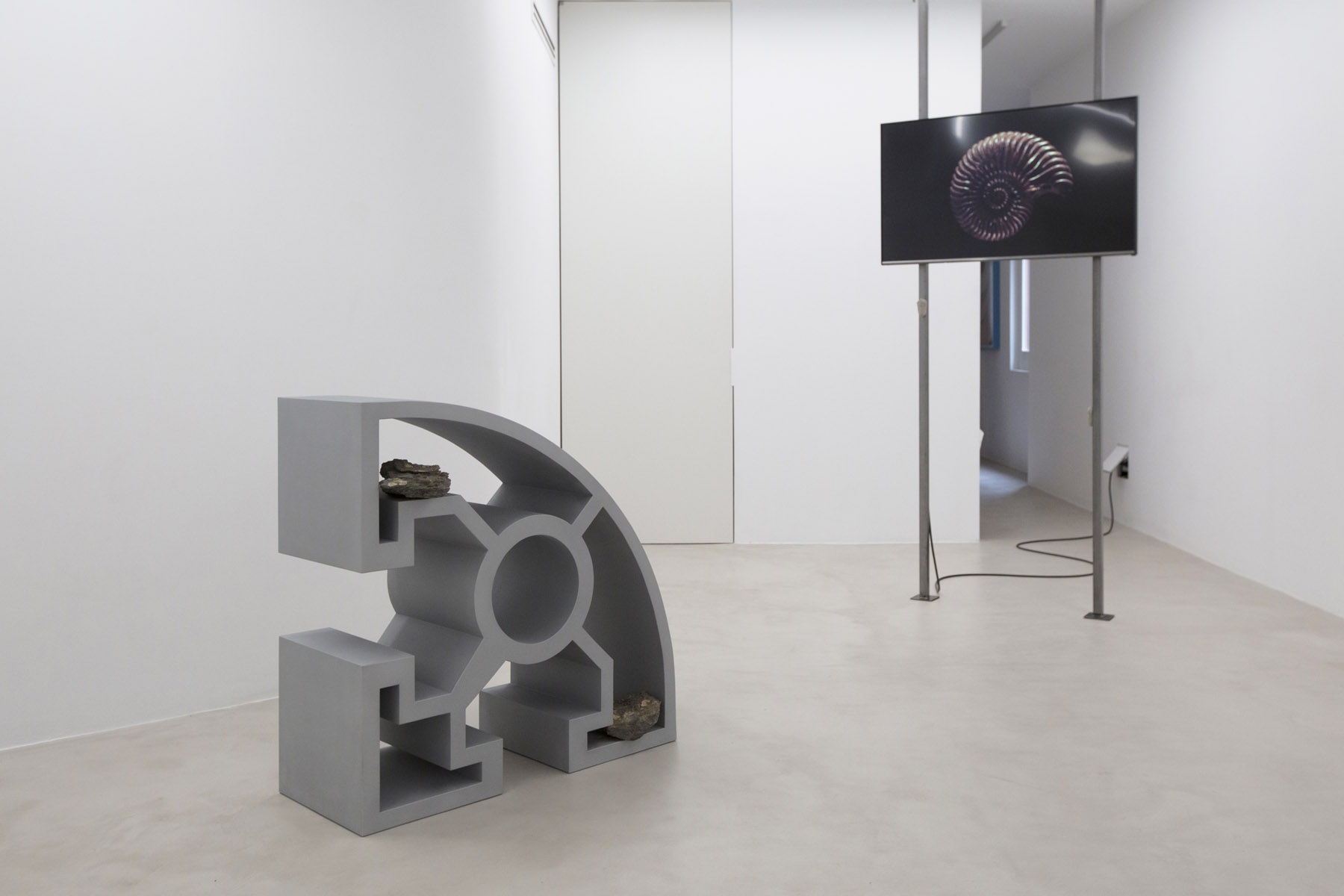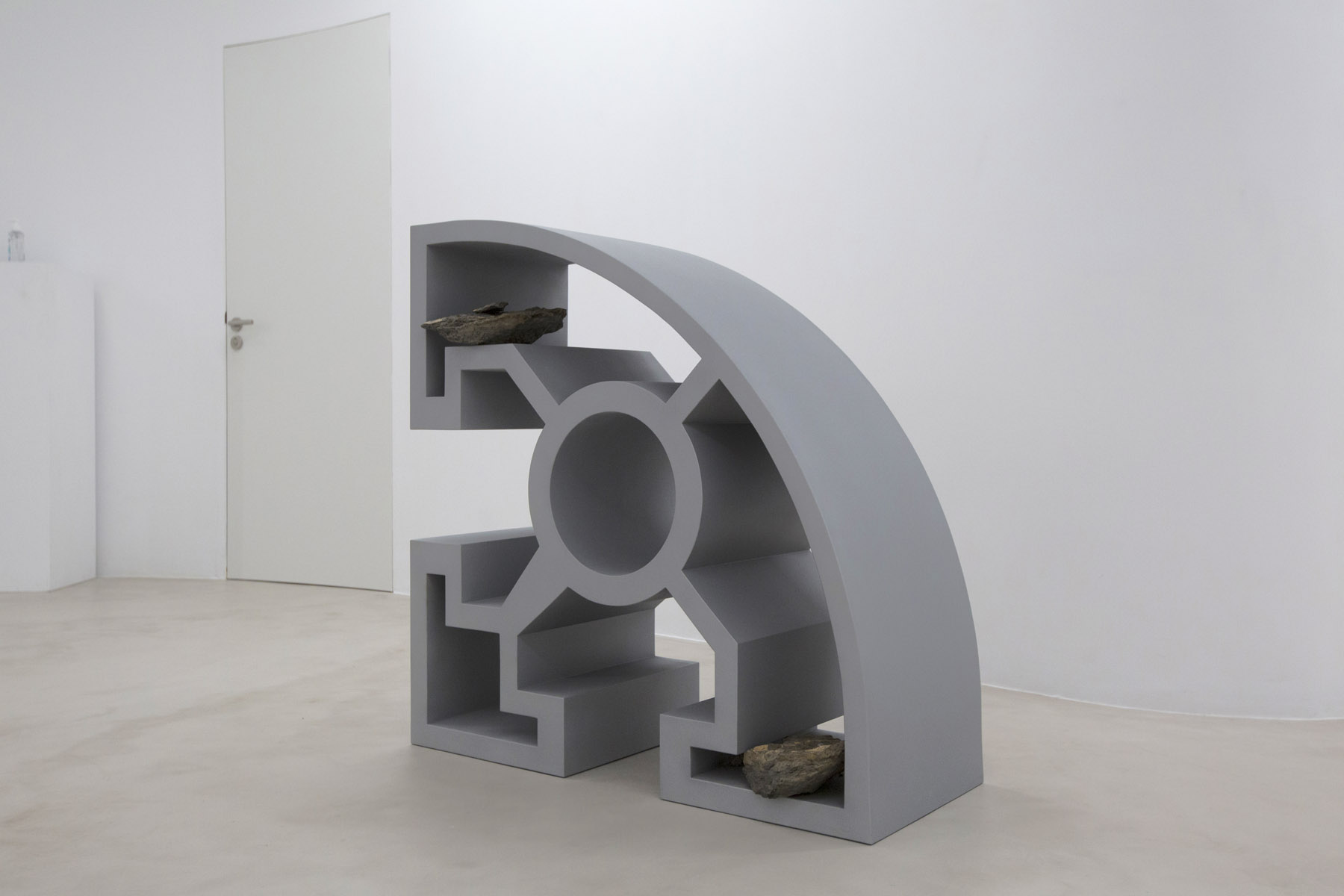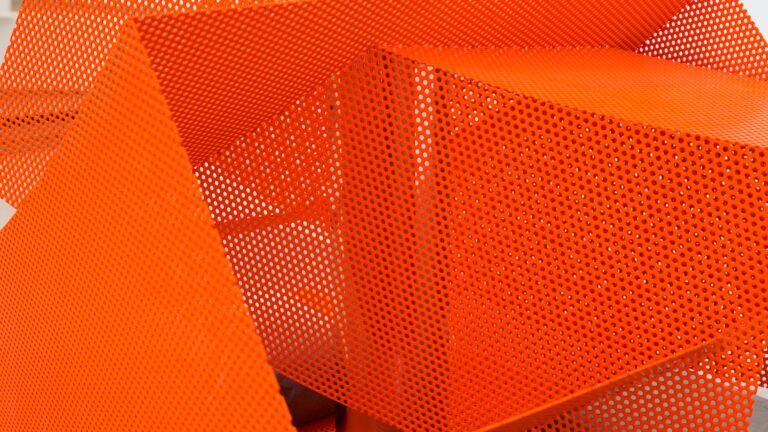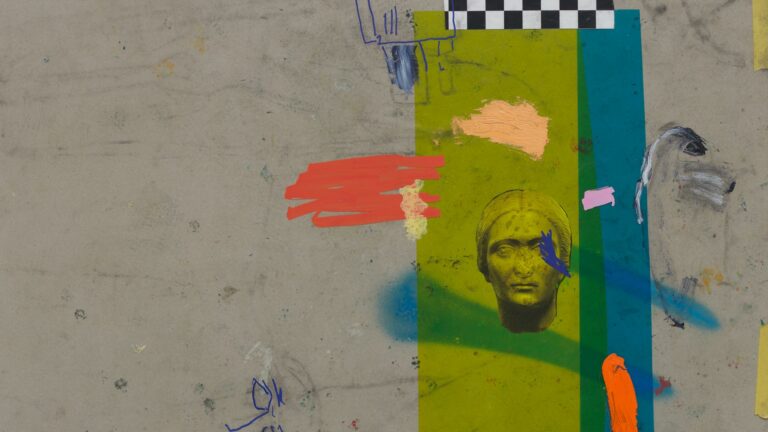Artist: Amanda Moreno
Exhibition title: The Sky Was Made of Amethyst
Curated by: Caterina Almirall
Venue: Espai Tactel, Valencia, Spain
Date: September 25 – November 27, 2020
Photography: all images copyright and courtesy of the artist and Espai Tactel, Valencia
The amethyst is stone of magmatic origin. Also known as igneous rocks, this type of rock comes from the magma that is found inside the earth. Magma is a mass of molten stone. Stones and minerals are the base of our planet, and dead matter, fossil material. Waste and gold, mineral and oil, animal and vegetable, plastic and sand, bones and guts.
The amethyst is a type of violet quartz. The colour may be of varying intensity, according to the quantity of iron it contains. The more intense the colour the more valuable the stone. It is the crystal of February. Its properties are connected to the third eye chakra, the centre of spirituality and intuition, and also the chakra of the crown, which governs our connection with the universe. The colour violet is the colour in which opposites unite and come together, marking the limits between the invisible and the visible, and where the rainbow joins invisible ultraviolet.
These stones not only talk to us of something very ancient or dead, but also show us the history of the planet, to tell us that this distant past of the earth is connected with the living present and informs us of the future.
Amethyst was a mortal woman Bacchus had fallen in love with. Bacchus was the Greek god of wine, celebration and debauchery. Her name comes from the Greek amethystos: from the prefix “non” and methystos, “intoxicated”, which means “non-drunk”. The legend tells us that Amethysta, in order to escape from the harassment of the wine god, asked Artemis, goddess of the animal world, hunting and virginity, for help. She heard her plea and to help her turned her into a rock of white quartz. Due to this story the amethyst crystal used to be considered an antidote to drunkenness, and also a symbol of purity and divine wisdom.
The work of Amanda Moreno carries us to this timeless place, to the myth of the fossil. A moment which we can sometimes read in the rocks, sometimes remember in our bodies, and we name in order to not forget. Names such as Amethyst or like Qfwfq, or “the cambric explosion”. Qfwfq is the narrator of the Cosmicomicas by Italo Calvino, who tells us what is was like to live at one single point: Each point of ours coincides with each point of everyone else in single point that was that where everyone was. Amethyst was the girl who became a stone, and the Cambric period was a geological period. The “Cambric Explosion” was an “explosion” of forms of like which created many of the life forms we know today. In the fossil records of this period we find the most primitive members of many of the multi-cellular animals that later on would become modern animals. These first multi-cellular forms, like the poor girl Amethyst, later metamorphosed into rocks and became material memory.
In A Thousand Years of Non-lineal History by Manuel de Landa, the fossil becomes the evidence for the on-going evolution between meat and stone, a form in which bodies remember their mineral planetary origins on “crossing the threshold of the return to the world of rocks”. By generating simultaneity between the mineral and the human, Amanda Moreno stimulates our capacity to remember a previous life form, the re-living of our lithic existence, between what the earth has done and what we have done ourselves. The earth makes rocks and forms and movement and heat, we, with this heat, make tools and artefacts, and we give them mythological names, filling the earth with mythical places. If magma in movement makes rocks, does and un-does continents, superimpose and amass materials to form a temporal conglomerate, Amanda reminds us that we too form part of this mass.
The geology theory, which explains this process and began at the end of the XVIII century, was called “Plutonism” from Pluto, the Greek god of the underworld. The supporters of plutonism were completely against “neptunism” which supported the idea of the underwater formation of minerals and the concept of the “universal ocean”; the plutonists bluntly rejected the theory that water could produce any effect on minerals. Today, however, there are those who state that the origins of water are in rocks, from an analysis made of meteorites coming from outer space, which may have been the carriers of the extra-terrestrial water molecules which ended up in the oceans. We could say that the development of scientific geological theories over history is full of myths.
It was the same plutonic theorist, James Hutton, who coined the term “Deep Time” to refer to the time of the origin of the earth (4.54 thousand million years). A time before time, a time without time or space which Qfwfq describes. Deep Time is essentially a “geological time”, a temporality which we humans just can’t imagine, but as Landa and Amanda Moreno suggest, “we can feel”. This is why we have the term “affective geology”. Dana Luciano defends this idea of a much needed anthro-decentralized re-thinking of the sensory, a revision of the divisions between the senses and modern sensorial hierarchies. This refers to the habit of many geologists to talk of Deep Time in terms of bodily sensation. Going back to the observation of Hutton himself, the concept of a “lytic nonconformity”: a rock formation in which two rock units coexist dating back to far-off geological periods separated in time with lapse of more than 50 million years. ¡50 million years! Deep Time shows itself in exactly that which can’t be seen, through a gap in the rock records, and so may offers “palpable evidence”. Luciano proposes that by the “sense in geological time” we can position different notions to think about what is possible to feel in the body.
When we are sitting on that mass which was once the ocean bed, or when we hold a fragment of fossil, or when we imagine the shapes of the proto-continents named after such fantastic beings as Pannotia, Rondinia, Gondawa or Pangea. We face the dizzying effect of a fall into the temporal abyss. The effect which goes through our body, more than through our mind and which demands the power of imagination to resolve itself. We may talk in this way of the agency of inorganic material. The voice that talks of “Your Fossil Existence”, by Amanda Moreno, embodies the proposal of a incarnate knowledge and of lytic sensorial thinking. Luciano relates this to the words of Audre Lorde when she states how women might attend to what sensual pleasure has to teach. Ultimately it is a feminist proposal of approaching the material world, which recognizes the contact and the experience of the body as activator of critical knowledge.
The amethyst sky is the first line of the song Violet by the band Hole. A song of falling out of love sung screaming, under a bright violet sky.
-Caterina Almirall
Amanda Moreno, The Sky Was Made of Amethyst, exhibition view, Photo: Nacho López Ortiz
Amanda Moreno, The Sky Was Made of Amethyst, exhibition view, Photo: Nacho López Ortiz
Amanda Moreno, Profile 4M and Your Fossil Existence, Photo: Nacho López Ortiz
Amanda Moreno, Profile 4M, aluminum and fossil matter, 100 x 100 x 40 cm, 2020, Photo: Nacho López Ortiz
Amanda Moreno, Profile 4M, aluminum and fossil matter, 100 x 100 x 40 cm, 2020, Photo: Nacho López Ortiz
Amanda Moreno, Profile 4M, aluminum and fossil matter, 100 x 100 x 40 cm, 2020 (detail), Photo: Nacho López Ortiz
Amanda Moreno, Your Fossil Existence, 2020, digital video, stereo, color and sound, 16:9, 5 min, 20 sec, Photo: Nacho López Ortiz
Amanda Moreno, Your Fossil Existence, 2020, digital video, stereo, color and sound, 16:9, 5 min, 20 sec
Amanda Moreno, Profile 4M, fossil matter (detail), Photo: Nacho López Ortiz
Amanda Moreno, Profile 4M, fossil matter (detail), Photo: Nacho López Ortiz
Amanda Moreno, Untitled (carboniferous#1 and #2), print on paper, photography, 50 x 75 cm, 2020, Photo: Nacho López Ortiz
Amanda Moreno, Untitled (carboniferous#1), detail, Photo: Nacho López Ortiz
Amanda Moreno, Untitled (carboniferous#1), print on paper, photography, 50 x 75 cm, 2020
Amanda Moreno, Untitled (carboniferous#2), print on paper, photography, 50 x 75 cm, 2020
Amanda Moreno, Profile 3A, aluminum and fossil matter, 100 x 100 x 40 cm, 2020, Photo: Nacho López Ortiz
Amanda Moreno, Profile 3A, fossil matter (detail), Photo: Nacho López Ortiz
Amanda Moreno, Profile 3A, aluminum and fossil matter, 100 x 100 x 40 cm, 2020, Photo: Nacho López Ortiz
Amanda Moreno, Profile 3A, fossil matter (detail), Photo: Nacho López Ortiz
Amanda Moreno, Profile 3A, aluminum and fossil matter, 100 x 100 x 40 cm, 2020, Photo: Nacho López Ortiz
Amanda Moreno, Gorgonian Aura, 2020, digital video, stereo, color and sound, 16:9, 14 min, Photo: Nacho López Ortiz
Amanda Moreno, Gorgonian Aura, 2020, digital video, stereo, color and sound, 16:9, 14 min
Amanda Moreno, Gorgonian Aura, 2020, digital video, stereo, color and sound, 16:9, 14 min, Photo: Nacho López Ortiz
Amanda Moreno, Gorgonian Aura, video installation video (detail), Photo: Nacho López Ortiz
Amanda Moreno, Gorgonian Aura, video installation video (detail), Photo: Nacho López Ortiz
Amanda Moreno, Your Fossil Existence, 2020, digital video, stereo, color and sound, 16:9, 5 min, 20 sec, (frame)
Amanda Moreno, Your Fossil Existence, 2020, digital video, stereo, color and sound, 16:9, 5 min, 20 sec, (frame)
Amanda Moreno, Your Fossil Existence, 2020, digital video, stereo, color and sound, 16:9, 5 min, 20 sec, (frame)
Amanda Moreno, Gorgonian Aura, 2020, digital video, stereo, color and sound, 16:9, 14 min, (frame)
Amanda Moreno, Gorgonian Aura, 2020, digital video, stereo, color and sound, 16:9, 14 min, (frame)
Amanda Moreno, Gorgonian Aura, 2020, digital video, stereo, color and sound, 16:9, 14 min, (frame)
Amanda Moreno, Gorgonian Aura, 2020, digital video, stereo, color and sound, 16:9, 14 min, (frame)
Amanda Moreno, Gorgonian Aura, 2020, digital video, stereo, color and sound, 16:9, 14 min, (frame)
Amanda Moreno, Gorgonian Aura, 2020, digital video, stereo, color and sound, 16:9, 14 min, (frame)
Amanda Moreno, Gorgonian Aura, 2020, digital video, stereo, color and sound, 16:9, 14 min, (frame)






































